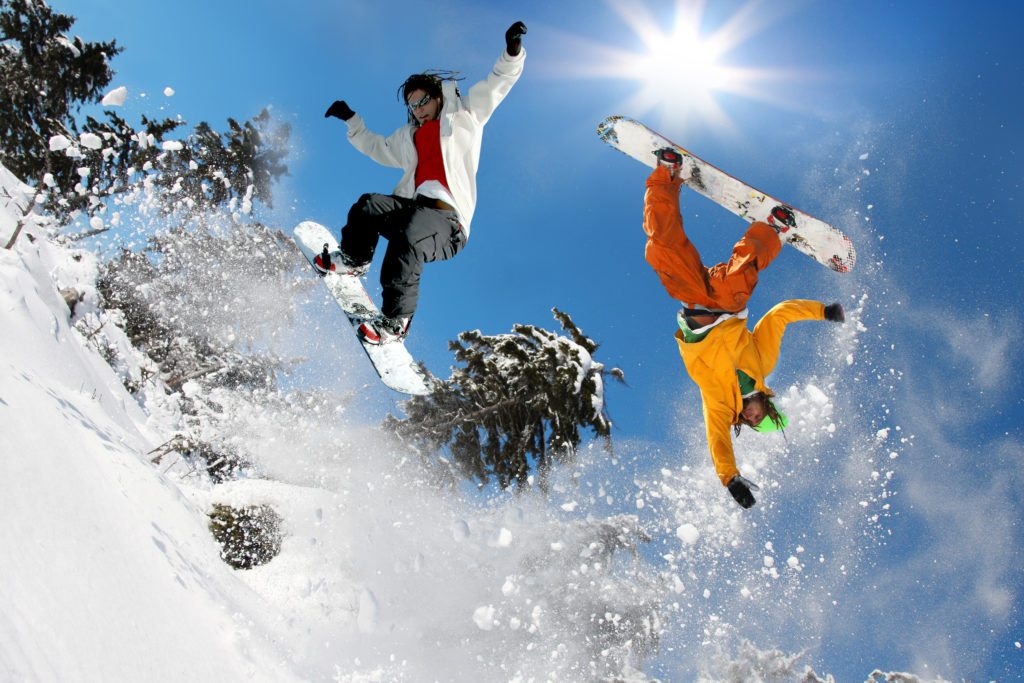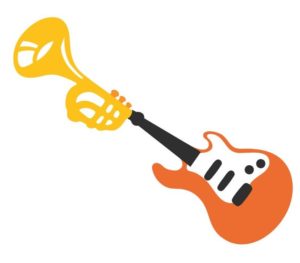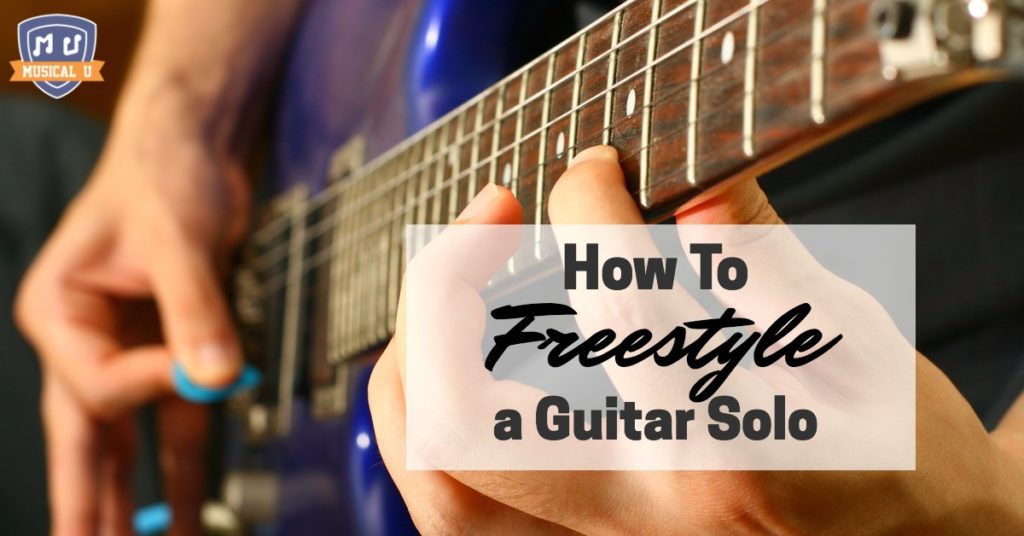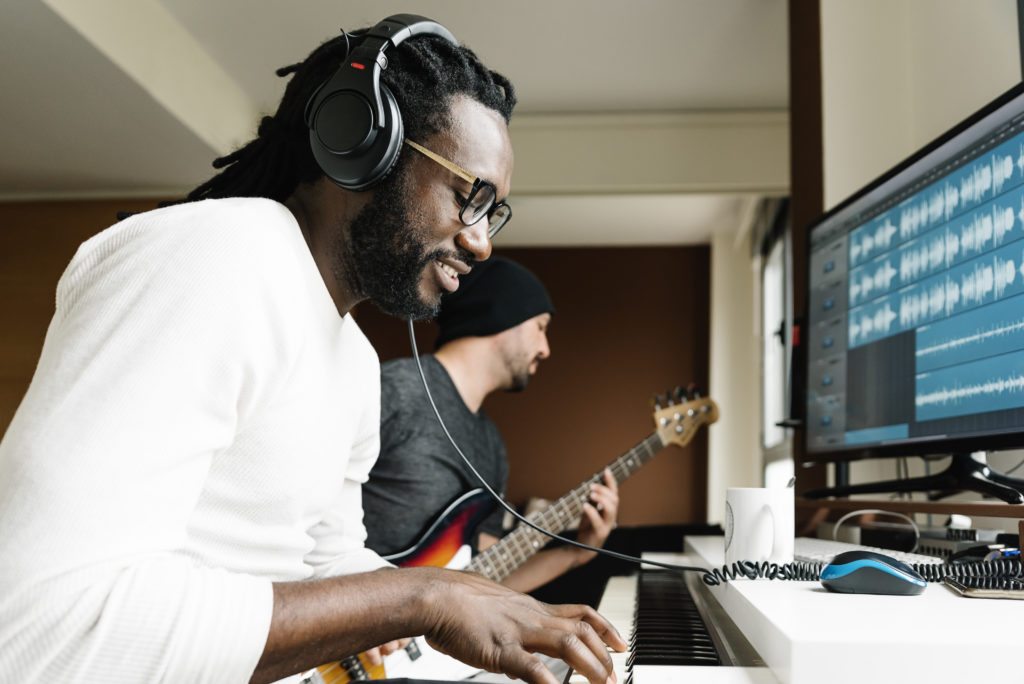Ever vaporized into awe and envy as your favorite shredder picked up a guitar and pulled a face-melting freestyle improv out of nowhere? How do they do that?
It’s one thing to do that with a full band backing you up. And with your solo neatly framed within the eight or 16 bars labeled “guitar solo” on the chart.
But what if you’re just you, out there, all alone? No band, no boundaries, no rules…
We can all give examples of what we think is “freestyle”, but it’s a little harder to define the word. If we look at it’s cultural history, it seems that freestyle originated in a certain type of swim race, where swimmers are free to choose any stroke they want.
Still today, freestyle has competitive connotations – from snowboarding to rap battles which highlight spontaneously improvised creative displays of individual skill.

So while the word is found in many contexts, first let’s focus on three essential qualities that seem to describe the bulk of what is today known as “freestyle” guitar:
1. Improvisation
One of the most important misconceptions about musical improvisation (defined as “spontaneous composition” and also simply referred to as “making it up as you go along”) is that you just play whatever you want.
The truth is that music is a language. When you engage in a conversation you won’t be using incoherent sentences and putting words out of order, inventing new phrases, letters and sounds on the spot in hopes to “go with the flow, because you’re so free”. You’ll be hospitalized within minutes.
The same is true for music (ok, maybe not the hospital part). If go around with that “play whatever” mentality, other musicians won’t want to play with you, and audiences will not want to listen either.
Music becomes music when it acquires form, and freedom is acquired once you’re aware of the rules and know how to go in and out of them. This can be seen as the concept of tension and release, or call and response – the universal concept of developing ideas in music and other art forms as well.
So, while freestyle soloing may have less rules than other forms, if there were no boundaries the results may be completely unintelligible. A freestyle rapper isn’t going to break his flow and bust out a classical violin. A freestyle snowboarder isn’t going to interrupt his routine for a brief nap.
2. Going Solo
While some refer to any improvised performance as “freestyle”, here we’re talking about a guitar solo with primarily no back-up – like, totally alone.
Playing a meaningful solo performance on the guitar can acquire various forms, depending on the genre. So before you begin try creating a clear picture in your head of what are you going to do. Yes, improvisation is about using what you know and having some sort of structure.
Let’s talk about a more controlled environment for your solo first. What are the things that may help you to not run out of ideas in the middle and bore your listener?
Think form.
Telling Your Story
While you may not be constrained to the space of a set amount of bars in a song, there are other ways to structure your freely improvised solo.
Millions of widely diverse literary stories from all cultures from time immemorial have shared the following structure:
- The Setup – introduction
- A Problem – what drives the story forward
- Catalyst – an incident that drives things in motion
- The Resolution – the coda, the grand finale
And it works for music, too. This is true for improvisation on any instrument.
You want your audience to be excited and follow your story. As a performer, you are the one responsible for keeping the crowd “pumped”.
And having a structure to your music will help guide your listener.
That structure, the musical “language” that you choose, may depend on your audience. When people listen to improvisational, modern and complex forms of jazz they think then musicians play whatever, because they are not accustomed to tracing the structures of that “language”.
 Let’s say you’re planning a solo punk piece: you’ll want to pursue a musical language that is true to your genre. You have several options, for example starting out slow and gradually building or slamming right in. You’d still to want to bring in variations, breakdowns, builds and everything that will keep the people going, like they’re riding a wave.
Let’s say you’re planning a solo punk piece: you’ll want to pursue a musical language that is true to your genre. You have several options, for example starting out slow and gradually building or slamming right in. You’d still to want to bring in variations, breakdowns, builds and everything that will keep the people going, like they’re riding a wave.
3. Skill
While it’s good to freestyle at any level of playing, part of the joy of the form is the spectacle of skill. The more skills you have to display, the more fun for you and your audience.
Where To Start?
Where do you start if you want to feel comfortable playing solo guitar?
In short, build your vocabulary and find creative ways to interpret it.
To put it another way, you’ll want to build your craft in the genre you’re working with. Know your:
-
Melodies
-
Harmonies
- Triads
- Seventh chords
- Chord extensions
- Chord substitutions
-
Rhythm and Form
- Form: think in phrases (2 bars, 4 bars, 8 bars, 16, bars, etc)
- Play around with interesting rhythmic patterns
Every genre will have certain prevalent specifications:
- A modal solo will focus on using modes, creating melodies and their variations
- An avant-garde solo may seem to go completely off the grid, but there will still be sequences, form, rhythmic motives and other elements that hold it together.
- A blues solo will follow the blues scales and chord structure, and build interest with licks, bends, and playing off the form.
The bottom line is you’re able to bend the rules as much as you want and nobody can tell you you’re wrong, as long as you put in time to know what rules you’re bending: study the craft and build your vocabulary. Your vocabulary = your sound. Be innovative.
Let’s look into some freestyle greats from the past:
Freestyle Jazz: Joe Pass
If you’re looking for a solo jazz guitar improv, Joe Pass is known to everyone familiar with jazz music as “the guy”.
As mentioned before, having some sort of a form in your head will help to make it easy to follow the flow of ideas.
I bet that any of you listening to the video will be tapping your foot on the floor. Also you will notice “sonical logic” when he plays chords. You feel how they roll into one another. In this example, Joe Pass is doing a solo improv on “Misty” – a famous jazz standard. He doesn’t always play perfectly in time – however, the form is there, the references to the main melody are also there, the chord progression with the main turnaround, too, etc.
Listen to the recording from [0:20 to 0:35]. If you pay close attention you can clearly hear him leading two voices at a time, the melody and the bassline, of course, mixing it all up with the chords in-between. The bassline clearly follows the chord structure of “Misty”.
To play a solo like this you’ll have to master your “language” and be really on point with things like common licks, chord fingerings, chord substitutions, your scales and arpeggios and more.
Lessons Learned
You could take on the same approach for any genre. Let’s say you’re about to crush it playing a rock solo. The previous example already gives you an example on how to develop your ideas. You can consider the bassline and melody approach and play on contrast, you can blend in some power chords, and you can take common blues chord structure to give your ideas a form.
You don’t necessarily have to stay in perfect time and follow these kind of solos. You can slow down and you can speed up, play a couple of quarters more per measure. But introducing harmonic structure will help you guide yourself and your listener. Predictability and anticipation are your friends.
Freestyle Rock: Jimmy Page
Feast your ears (and eyes) on Jimmy Page’s solo on “White Summer”. It’s a solo piece that goes into a duo section with drums and then to an impromptu section and then back to the main theme of the piece.
This performance gives us a few cool ideas on how to build a performance. Again, it’s clear that the form plays a major role in here. Jimmy goes in and out from one section to another and alternates an improvised section with a written piece all the time.
The main melody of “White Summer” always comes back to remind a listener about the song. As with much improvisation, not everything has to be spontaneous: I can guarantee you that a lot of the “cool moments” in this piece were somewhat worked out, and I’m sure that Jimmy and John had countless of similar jams and they really knew what they were going for.
As you’d expect from a rock performance you can hear a lot of pentatonic and modal licks. Quite often Jimmy is playing out of time and uses sparse melodic phrases to go back into a rhythmic section.
Suggestions On Developing Your Solos
If you’re doing a show and there’s a section when you’re playing a solo part, then you have to be prepared for it – you’re playing for the audience, and audiences can get bored. Which is the last thing you want to happen.
Consider the Elements
Keep these foundational musical principles in mind:
- Key – will narrow down your note choices
- Tempo – will keep your rhythms lined up
- Form – will help you build a structure for your “story”
- Harmony will help you creating a direction, phrases, tension and resolution.
- Melody – some of the best improvisers always work on developing a melody and creating variations on a theme.
Just by considering these basic elements you can already have a rather solid direction of where you’re heading. Improvisation is about applying your existing knowledge and skill sets in a new and creative way.
You will always rely on your musical vocabulary: magic does happen, but most of the time it will require hours of preparation before you step into the unknown.
Record Yourself
Start by recording yourself doing a short improv performance, perhaps a couple of minutes long. First, play a solo by jumping right into it without any prep work and then play a solo by creating a roadmap first. Record it, listen back and evaluate for yourself what worked better.
Playing your way back in
Of course, if you’re jamming by yourself, then you might want to relax and not think about things and simply mess around. Here’s a fun exercise, and very useful to do in the practice room so you’re prepared for the craziness that can happen on stage: start in keeping with the plan, staying inside the box. Then really mess it up with some out of key notes or way-off rhythms and try to play your way back in.
When you try this, keep in mind the words of one of my mentors: whenever I played something out of time or something incoherent, he would say, “Whatever you play, make music out of it!” I think those are wise words that made me a better musician and value my abilities more.
Fresh Inspiration
Where to get more ideas for your guitar solos? Personally, I always found it particularly interesting to study solos done on other instruments, and then emulating that sound on the guitar.
The musical structure of our first example with Joe Pass is somewhat similar to what you can do on a piano. That is, leading a walking bass line and playing upper chord structures for harmony and the melody.
 Of course, in some ways pianists have broader possibilities compared to guitarists: they use different voicings, it’s easier to play counterpoint, and you can use all 10 fingers… to name a few. However, transcribing your favourite piano solo and arranging it for the guitar may open up doors to many great ideas.
Of course, in some ways pianists have broader possibilities compared to guitarists: they use different voicings, it’s easier to play counterpoint, and you can use all 10 fingers… to name a few. However, transcribing your favourite piano solo and arranging it for the guitar may open up doors to many great ideas.
Another example that comes to mind is the brass, particularly the trumpet. Well-known fusion guitarist Pat Metheny uses a guitar synthesizer to simulate a trumpet and emulates phrasing similar to what a trumpet player would use.
Compared to the piano, trumpet can only play one note at time, but it has amazing dynamic possibilities. How would you approach your guitar solo if you were thinking as a trumpet player? The more you carefully listen to solo performances on different instruments, the more creative ideas you can get.
Are You Ready to Freestyle?
Improvisation is one of the most complex and rewarding tasks in music. Even more so, solo performance. Spend time acquiring essential building blocks that you can reuse, morph, deconstruct and create upon again and again.
One sure way to initiate this process is through playing a great variety of exercises. It is inevitable that you’ll be relying on the acquired arsenal of knowledge in your solos, so might as well make sure to expand your vocabulary whenever possible, as much as possible.
The good news is that you don’t have to wait. The cool thing is that improvisation, solo playing, and skill building all work together to build each other.
Take everything that you learn and play with it, now! The sooner you apply your skills to improvisation, the quicker you will absorb them into your personal musical language. Freestyle isn’t just the end result – it’s an invaluable learning tool in itself. So what are you waiting for? Go pick up that guitar and jam!









